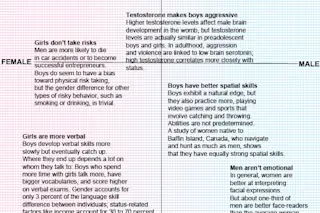This article is a sample from DISCOVER's special issue on the brain.
Four years ago, when Lawrence Summers suggested that the scarcity of prominent female scientists and engineers was in part because there are fewer women on the extremes of the range of innate math ability—fewer geniuses and fewer duds—he stirred up a lot of misguided arguments about gender differences in the brain. Although the former president of Harvard University and current director of the National Economic Council may have been right on a few details, he was wrong on his major point.
Men’s and women’s brains are different, but those distinctions are much smaller than we typically think, and few of them are innate. Rather, the slight asymmetries present at birth, shaped and molded by interests, predilections, and the cues of parents and teachers, grow into more significant gender gaps in adulthood. This divergence is an example of plasticity, ...















